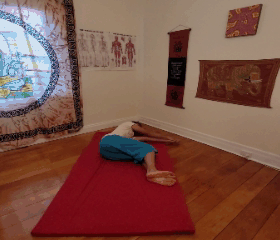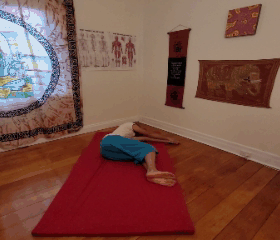Latissimus Dorsi and exercises
Latissimus dorsi is a thoracic back muscle that seats superficial to the Erectos Spine muscle groups.
As better explained in the table below, one of its main actions is to rotate the thoracic.
Latissimus Dorsi (LD) is occasionally related to back pain symptoms.
Along with this blog post, we will go through a series of exercises to facilitate of Latissimus Dorsi.
| Origin | Spinous processes of thoracic T7–T12, Thoracolumbar fascia Iliac crest Inferior 3 or 4 ribs The inferior angle of the scapula |
| Insertion | the floor of the intertubercular groove of the humerus |
| Action | Adducts, extends and internally rotates the arm when the insertion is moved towards the origin. When observing the muscle action of the origin towards the insertion, the lats are a very powerful rotator of the trunk. |
Now, given away the specification of lat Dorsi we start to get a clear idea of how this muscle can be involved in back pain, especially when going to a rotation or opening the arm side wise (Adduction).
Given its origin point, along the Illiac crest and the Thoracolumbar fascia, LD takes part along with Gluteus Max to what we call, Oblique Muscle Sling.
Indeed, in the case of the predominant force of the LD, we may observe weakness in the G. Max.
Said so, the LD is a muscle that can be easily stretched out and reinforced.
To start with let’s look at how a massage therapist can reduce tension from LD.

In case of a Remedial Massage, to access and work on this muscle the patient is lying in a side position.
MFTT is a myofascial technique used to release fascial tension from this muscle, by stripping the skin over the muscle and by pulling passively the arm away from the chest.
On the other hand with Thai Massage the client will be seated on the floor, cross legs and both hands behind the head.
In this position, the LD is activated as the lumbar origin points are fixed to the ground and the insertion point is stretched.
So, initially the therapist seat on her/his knee behind the patient.
After that, she/he places a knee on the tight of the patient on the opposite side of Lat Dorsi that needs to be stretched, and by using her/his hands holds down the tight of the affected side and pulls side way the flexed forearm.
This type of stretch must be controlled and done gently.
Asking for constant feedback from the patient on how it feels is really important.
Despite how to release tension from this muscle with manual therapy, we can look into some corrective exercises.
Along with those exercises we include one of the Thai Yoga series.
In fact, this specific exercise from the Thai Yoga series is good for working on Lat Dorsi and on Gluteus Max at the same time.
Latissisum Dorsi exercises.
Open book.
- Start with lying down on the not affected side, with both knees flexed at 90° and arms and hands seating one on the other one, pointing away from the body.
- Have a pillow below the head.
- Start opening the arm of the affected side, by keeping the arm straight.
- As the chest and arm are opening, rotate with neck and head towards the same side.
- Stop immediately if you are experiencing pain (as you should not experience any pain) or stop when you feel the knees start moving.
- Close the arm and restart. Stop before the knee starts moving.
Book sliding page.
- As per the previous exercises lying down on the unaffected side with band knees and arms standing on each other, facing away from the body.
- This time, start sliding the hand seating above along the line of the other arm.
- As you slide the hand, as you go to reaching the chest, start rotating the head and neck.
- Again, stop if pain occurs or if the knees start moving.

- Close the arm and repeat.
Thai Yoga Lattissimus Dorsi twist.
- Seat on the floor with the leg in Thai Pray position, by placing the leg of the affected side flexed backwards.
- Hold the back up nice and straight.
- Take a deep breath in through the nose.
- And as you breathe out, start rotating with the thoracic towards the unaffected side.
- Stop if you feel pain, along the back or elsewhere or when you can rotate more.
- Keep rotating side to side, following the breathing in and out
Those Latissimus Dorsi exercises are recommended for those who are aware to have limited thoracic rotation.
If you are experiencing any sharp pain or nervy type of pain sensation along with these exercises, don’t practice them and book your next session to better evaluate what is happening there.
Giovanni La Rocca
Giovanni moved to Melbourne, Australia, from Italy in 2008 and became a citizen in 2017. He started studying massage therapy in 2016, then completed a Bachelor of Health Science in Clinical Myotherapy in August 2024. During those years, he also specialised in Thai Massage and Manual Lymphatic Drainage for presentations like Lipedema and Lymphoedema. Nowadays, he runs his clinic in Fitzroy North, Melbourne, where he integrates movement therapy into his practice to enhance overall well-being. He also values meditation, having completed several Vipassana courses. Committed to continuous learning, he aims to share his expertise in integrated therapies to help others achieve balance and resilience.